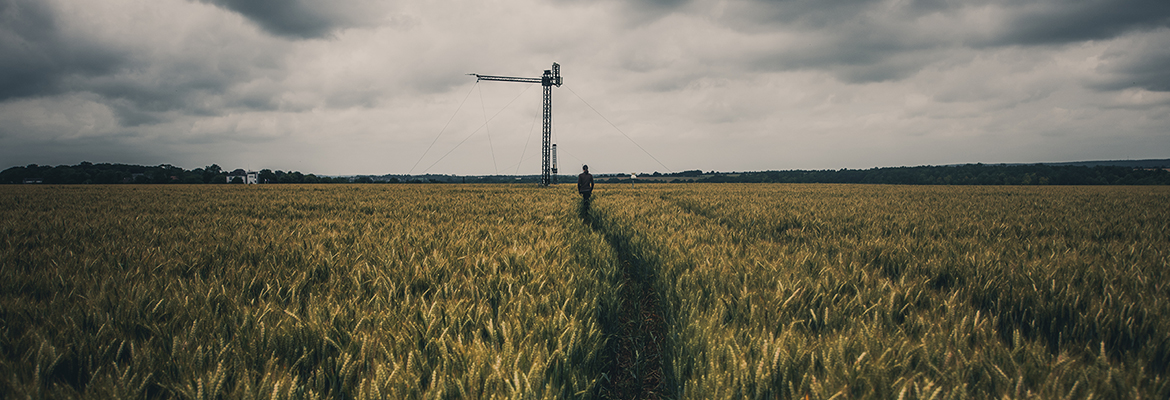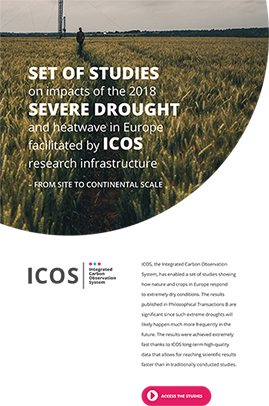
Extremely hot and dry summers are expected to be much more frequent in the future due to climate change. This is visible even now, the past summer being the third extremely hot summer in row. The areas of crops affected by droughts will also probably increase considerably, when carbon dioxide (CO2) levels continue to rise.
The 2018 summer had the largest ever area in Europe under extreme drought. Temperature records were broken in many regions of Central Europe and the UK, fires broke out in the Nordic countries, and several countries were affected by crop failures.
The 17 study results published in a special issue of Philosophical Transactions B in September 2020 show how vegetation in Europe responds to drought, i.e. how the exchange of carbon between the vegetation and atmosphere is affected. The studies cover areas from Spain to Sweden and Finland, and from the Czech Republic through Germany, France and Belgium to the Netherlands and the UK. The drought studies provide crucial knowledge when trying to minimise the negative effects of the climate change.
Joint research effort of over 200 top scientists
The 17 studies represent the work of over 200 scientists within the ICOS research infrastructure, representing all European top universities and research institutes. The scientists participating in the research effort cooperated extremely well, gathering a vast amount of data, points out Alex Vermeulen, co-organiser of the study and Director of the ICOS Carbon Portal: “We had open data exchange during process, resulting in the unique data sets openly available through ICOS Carbon Portal”. The first data sets were available already within 6 months since starting the initiative.
This all was possible thanks to the existing infrastructure and data of ICOS, which continuously measures important climate variables over 140 stations across Europe. The long-term high-quality data provided allows for reaching scientific results faster than in traditionally conducted studies.
“Being able to produce unique data sets and results in such a short time shows that research infrastructures such as ICOS are powerful tools enabling high-quality research. To adapt to the changing climate, we cannot rely on tens-of-years-old-knowledge: We must have timely information about the state of the Earth,” states Philippe Ciais, Research Director at the Laboratoire des Sciences du Climat et de l’Environnement (LSCE), France, and one of the organisers and editors of the theme issue.
“These drought studies demonstrate that the ICOS community is able to collaborate across disciplines, integrate various data streams and bring forth new knowledge to solve the challenges climate change sets all of us,” says Werner Kutsch, Director General of ICOS.
Forest carbon sinks decreased, crops were lost, and grasslands browned down
According to the results presented, the plants first profited from warm and sunny conditions in spring 2018, but then had not enough water available to their roots when the summer heat wave hit. Grasslands “browned-down” during the drought, causing to shortages of hay for cattle, and many crops produced the lowest yields in decades, causing financial losses for many industrial sectors. “Several studies show that the dryness of the soil affected the plants even more than e.g. the high temperature and the humidity of the air,” explains Ana Bastos, a scientist at Max Planck Institute, Germany, and one of the lead authors of the theme issue.
Many of the studies found that on the European scale, the forests protected themselves by reducing their evaporation and growth, leading to decreased uptake of carbon dioxide. Carbon sinks decreased in general by 18% according to a study covering 56 sites.
The dry conditions even turned some ecosystems from sinks into sources. However, rewetted peatlands seemed to survive better e.g. due to new plant growth. This is good news since rewetting peatlands is one of the means widely used to mitigate the consequences of the climate change.
Further, these studies show that the response of the vegetation to an extremely dry summer is strongly dependent on the conditions of the previous spring and even winter. In some parts of the Europe, the winter 2018 was wet, leaving a lot of soil moisture in the ground, while spring was sunny and came early - this caused the vegetation to grow more than average in spring, taking up more carbon from the atmosphere than usual. In some places, this early spring growth was enough to offset the reduction of carbon uptake later in summer. “If the scientific community could predict such droughts and their impacts several months prior to the drought, it would help in adapting to changing climate conditions,” ponders Professor Wouter Peters from the University of Wageningen, the Netherlands. Peters is one of the lead authors or the theme issue.
ICOS brochure on drought studies:

Articles and the lead authors, with direct links to the scientific articles
Wouter Peters, Ana Bastos, Philippe Ciais and Alex Vermeulen, Introduction: A historical, geographical and ecological perspective on the 2018 European summer drought. https://doi.org/10.1098/rstb.2019.0505
Ana Bastos et al., Impacts of extreme summers on European ecosystems: a comparative analysis of 2003, 2010 and 2018. https://doi.org/10.1098/RSTB.2019.0507
Michael Ramonet et al., The fingerprint of the summer 2018 drought in Europe on ground-based atmospheric CO2 measurements. https://doi.org/10.1098/RSTB.2019.0513
Naomi E Smith et al., Spring enhancement and summer reduction in carbon uptake during the 2018 drought in northwestern Europe. https://doi.org/10.1098/RSTB.2019.0509
Christian Rödenbeck, Sönke Zaehle, Ralph Keeling and Martin Heimann, The European carbon cycle response to heat and drought as seen from atmospheric CO2 data for 1999–2018. https://doi.org/10.1098/RSTB.2019.0506
Rona L Thompson et al., Changes in net ecosystem exchange over Europe during the 2018 drought based on atmospheric observations. https://doi.org/10.1098/RSTB.2019.0512
Damien Beillouin et al., Impact of extreme weather conditions on European crop production in 2018. https://doi.org/10.1098/RSTB.2019.0510
Alexander Graf et al., Altered energy partitioning across terrestrial ecosystems in the European drought year 2018. https://doi.org/10.1098/RSTB.2019.0524
Zheng Fu et al., Sensitivity of gross primary productivity to climatic drivers during the summer drought of 2018 in Europe. https://doi.org/10.1098/RSTB.2019.0747
Tarek S El-Madany et al., Drought and heatwave impacts on semi-arid ecosystems’ carbon fluxes along a precipitation gradient. https://doi.org/10.1098/RSTB.2019.0519
Anders Lindroth et al., Effects of drought and meteorological forcing on carbon and water fluxes in Nordic forests during the dry summer of 2018. https://doi.org/10.1098/RSTB.2019.0516
Janne Rinne et al., Effect of the 2018 European drought on methane and carbon dioxide exchange of northern mire ecosystems. https://doi.org/10.1098/RSTB.2019.0517
Mana Gharun et al., Physiological response of Swiss ecosystems to 2018 drought across plant types and elevation. https://doi.org/10.1098/RSTB.2019.0521
Natalia Kowalska et al., Analysis of floodplain forest sensitivity to drought. https://doi.org/10.1098/RSTB.2019.0518
Franziska Koebsch et al., The impact of occasional drought periods on vegetation spread and greenhouse gas exchange in rewetted fens. https://doi.org/10.1098/RSTB.2019.0685
Louis Gourlez de la Motte et al., Non-stomatal processes reduce gross primary productivity in temperate forest ecosystems during severe edaphic drought. https://doi.org/10.1098/RSTB.2019.0527